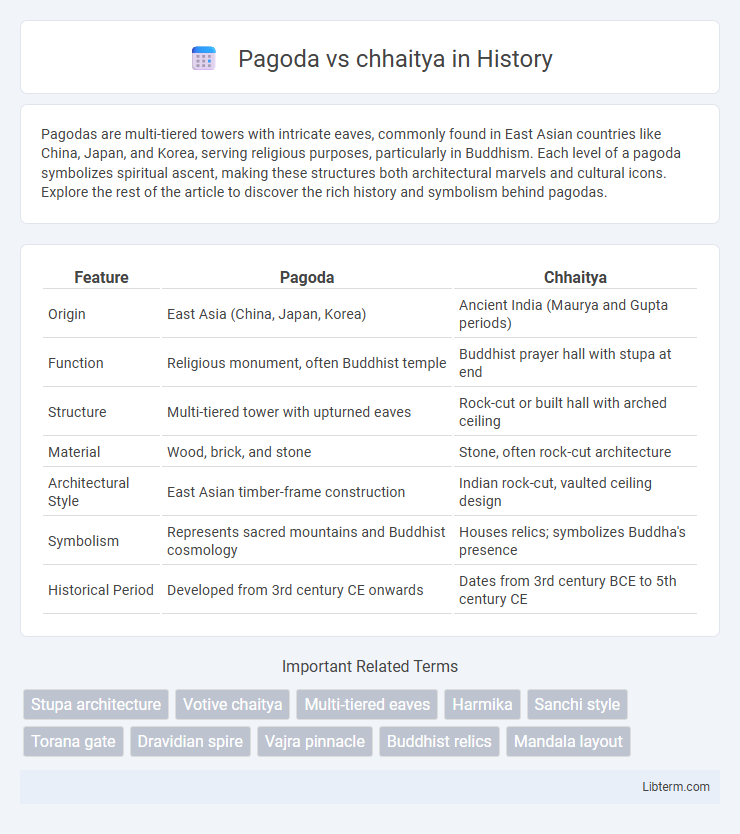Pagodas are multi-tiered towers with intricate eaves, commonly found in East Asian countries like China, Japan, and Korea, serving religious purposes, particularly in Buddhism. Each level of a pagoda symbolizes spiritual ascent, making these structures both architectural marvels and cultural icons. Explore the rest of the article to discover the rich history and symbolism behind pagodas.
Table of Comparison
| Feature | Pagoda | Chhaitya |
|---|---|---|
| Origin | East Asia (China, Japan, Korea) | Ancient India (Maurya and Gupta periods) |
| Function | Religious monument, often Buddhist temple | Buddhist prayer hall with stupa at end |
| Structure | Multi-tiered tower with upturned eaves | Rock-cut or built hall with arched ceiling |
| Material | Wood, brick, and stone | Stone, often rock-cut architecture |
| Architectural Style | East Asian timber-frame construction | Indian rock-cut, vaulted ceiling design |
| Symbolism | Represents sacred mountains and Buddhist cosmology | Houses relics; symbolizes Buddha's presence |
| Historical Period | Developed from 3rd century CE onwards | Dates from 3rd century BCE to 5th century CE |
Introduction to Pagoda and Chhaitya
Pagoda and chhaitya are distinctive architectural forms with deep roots in Asian religious traditions. Pagodas, typically multi-tiered towers, serve as Buddhist monuments primarily found in East Asia, symbolizing sacred relics and spiritual ascent. Chhaityas are ancient Indian Buddhist rock-cut halls designed for congregational worship, characterized by their vaulted ceilings and apsidal ends, reflecting early Buddhist architectural innovations.
Historical Origins of Pagoda and Chhaitya
Pagodas originated in East Asia, evolving from ancient Indian stupas and serving as tiered towers primarily used in Buddhist temple complexes, with their design influenced by Chinese and Japanese architectural styles. Chhaityas, rooted in early Indian rock-cut architecture dating back to the Maurya and Satavahana periods (3rd century BCE to 2nd century CE), function as prayer halls housing stupas and were integral to early Buddhist monastic communities. Both structures symbolize Buddhist religious practices but differ significantly in form and historical development tied to their distinct cultural regions.
Architectural Features: Pagoda vs Chhaitya
Pagodas feature tiered towers with multiple eaves, constructed predominantly in wood or stone, exhibiting a vertical emphasis and intricate bracket systems supporting wide, overhanging roofs. Chhaityas, commonly rock-cut or cave temples, showcase horseshoe-shaped vaulted ceilings and a longitudinal hall culminating in a stupa, emphasizing horizontal spatial flow and solid earthen materials. Architectural elements of pagodas highlight ornamental finials and layered symmetry, whereas chhaityas focus on simple, carved pillars and stupa-centric sanctuaries for ritual worship.
Symbolic Significance in Buddhism and Hinduism
Pagodas symbolize the layered ascent to enlightenment in Buddhism, often representing the Buddha's presence and the five elements: earth, water, fire, air, and space. Chhaityas, ancient Buddhist prayer halls, embody the sacred space of worship and enshrinement of relics, signifying spiritual devotion and the Buddha's teachings. In Hinduism, pagoda-like structures sometimes reflect cosmic mountain symbolism, while chhaityas are less prevalent but emphasize ritualistic sanctity and protection of divine relics.
Geographic Distribution and Prevalence
Pagodas are predominantly found in East Asia, especially in China, Japan, Korea, and Vietnam, serving as iconic religious structures mainly associated with Buddhism. Chhaityas are primarily prevalent in the Indian subcontinent, particularly in India and Sri Lanka, where they function as ancient Buddhist prayer halls or stupas. The geographic distribution highlights the East Asian architectural evolution of pagodas versus the South Asian origin and widespread use of chhaityas in early Buddhist contexts.
Construction Techniques and Materials
Pagodas employ wooden frameworks with interlocking brackets and tiered roofs that create flexible, earthquake-resistant structures, often adorned with tiles and intricate carvings. Chhaityas, typically rock-cut or brick-built Buddhist prayer halls, use stone or brick masonry with vaulted ceilings and horseshoe-shaped windows to allow natural light and ventilation. The pagoda's layered timber architecture contrasts with the chhaitya's solid, monolithic construction, reflecting distinct religious and regional building traditions.
Artistic Elements and Decorative Styles
Pagodas feature tiered eaves with upward-curving roofs, showcasing intricate wooden carvings and vibrant painted motifs reflecting East Asian Buddhist architecture. Chhaityas emphasize rock-cut architecture with horseshoe-shaped arches and elaborate stone reliefs, often adorned with sculpted stupas and symbolic motifs from early Indian Buddhism. The artistic elements of pagodas highlight verticality and ornamental woodwork, while chhaityas focus on structural simplicity enhanced by detailed stone carvings and symbolic decorations.
Role in Religious Rituals and Pilgrimage
Pagodas serve as prominent religious monuments in East Asian Buddhism, often housing sacred relics and acting as focal points for meditation, prayer, and ritual ceremonies during pilgrimages. Chhaityas, typically rock-cut Buddhist prayer halls found in India, are designed to facilitate congregational worship and rituals, featuring a stupa at the end that pilgrims circumambulate as an act of devotion. Both structures play essential roles in devotional practices, with pagodas emphasizing verticality and symbolic ascent, while chhaityas concentrate on communal ritual engagement and preservation of relics.
Evolution and Modern Adaptations
Pagodas evolved from traditional Indian stupas, integrating multi-tiered wooden structures prevalent in East Asia, while chhaityas originated as Buddhist prayer halls with rock-cut architecture in ancient India. Over time, pagodas adapted to incorporate intricate carvings and diverse roof styles, reflecting regional aesthetics across China, Japan, and Korea. Modern adaptations of both emphasize preservation alongside contemporary materials, blending historical designs with sustainable construction techniques.
Comparative Analysis: Key Differences and Similarities
Pagodas and chhaityas both serve as Buddhist architectural structures, with pagodas primarily found in East Asia and chhaityas in South Asia. Pagodas are multi-tiered towers with distinct eaves curving upwards, often built to enshrine relics and symbolize sacred mountains, while chhaityas are rock-cut or constructed prayer halls featuring a stupa at one end, designed for congregational worship. Both share the spiritual purpose of housing relics and facilitating meditation, yet differ significantly in form, regional style, and architectural techniques.
Pagoda Infographic

 libterm.com
libterm.com